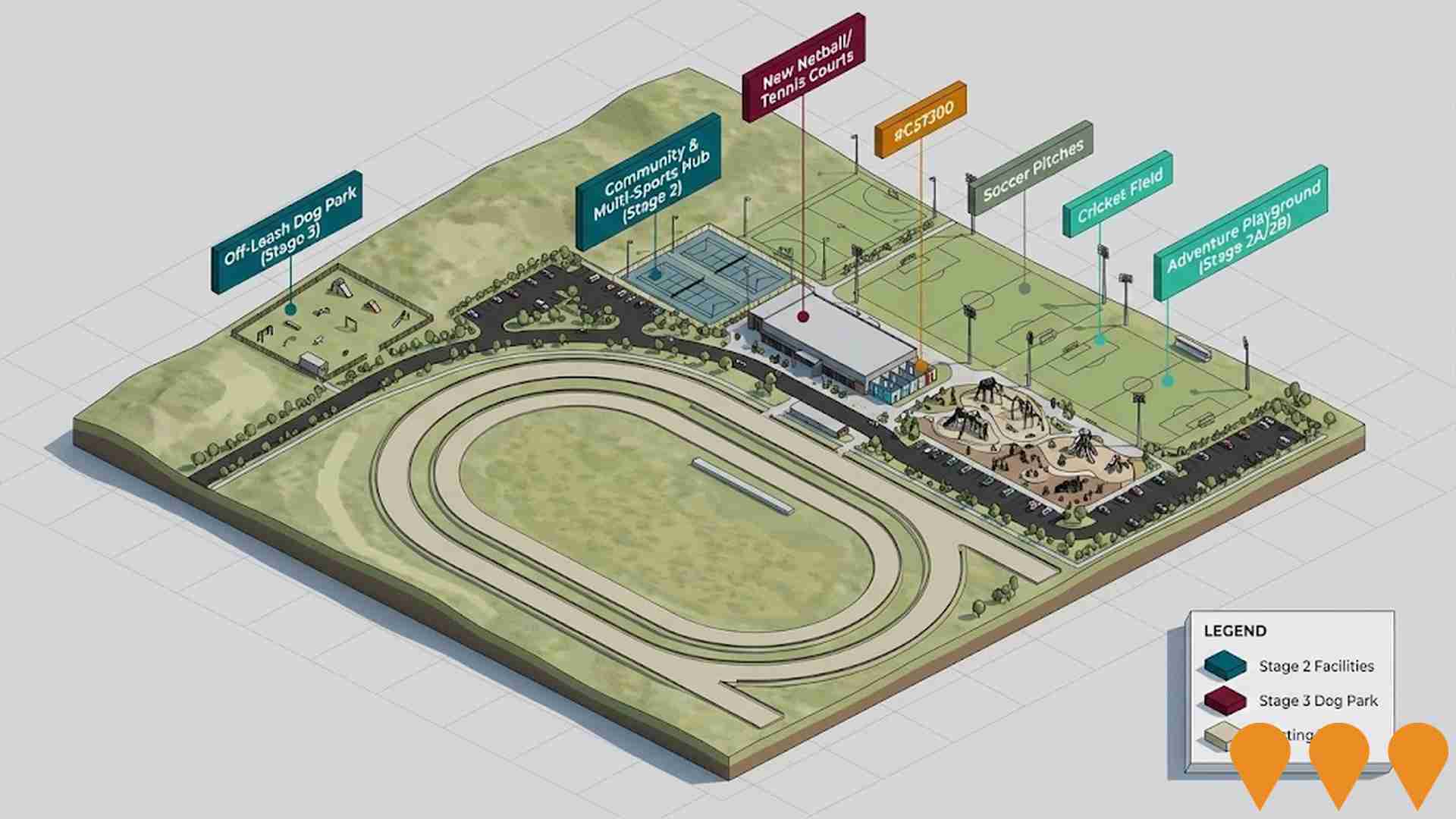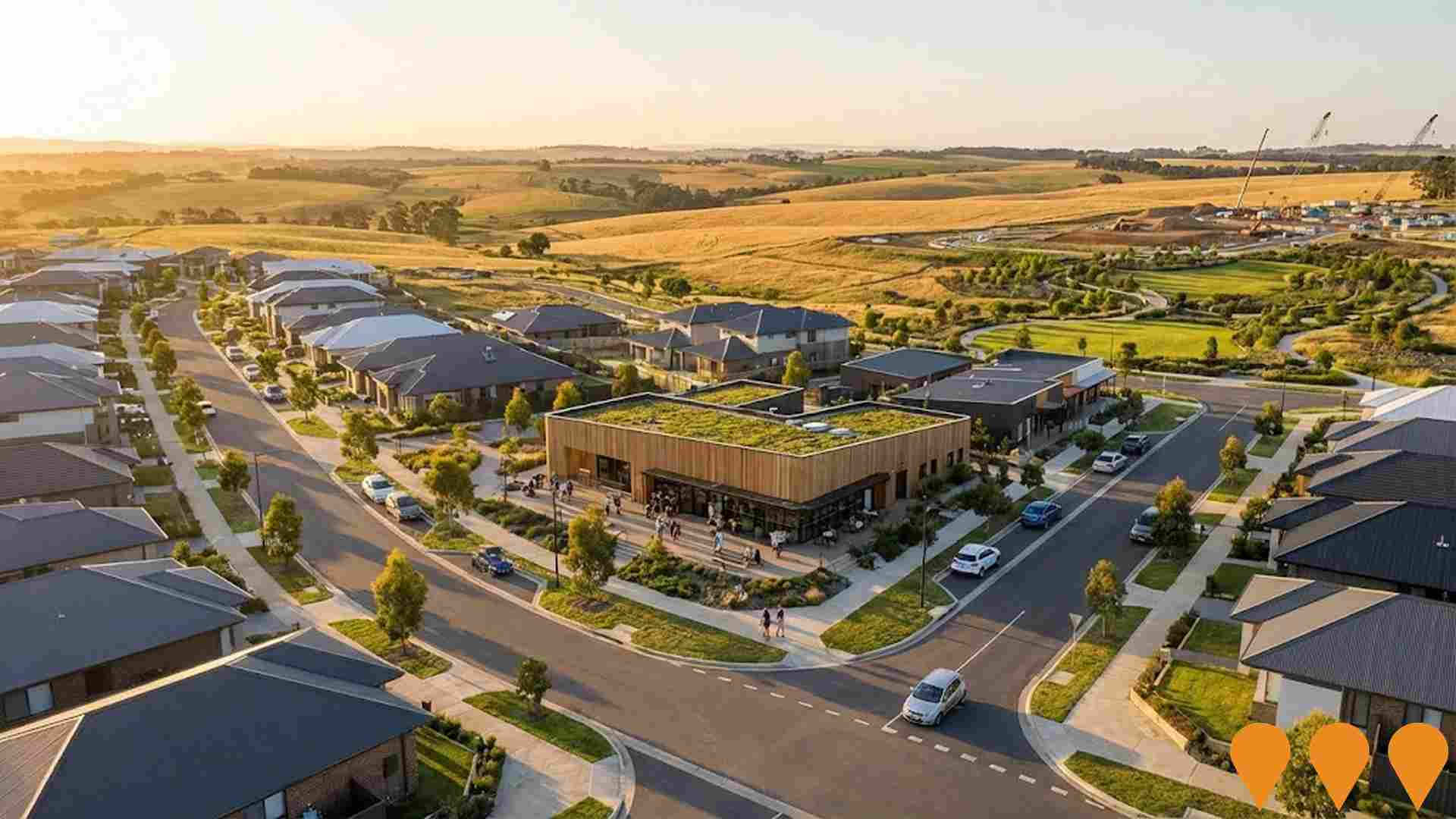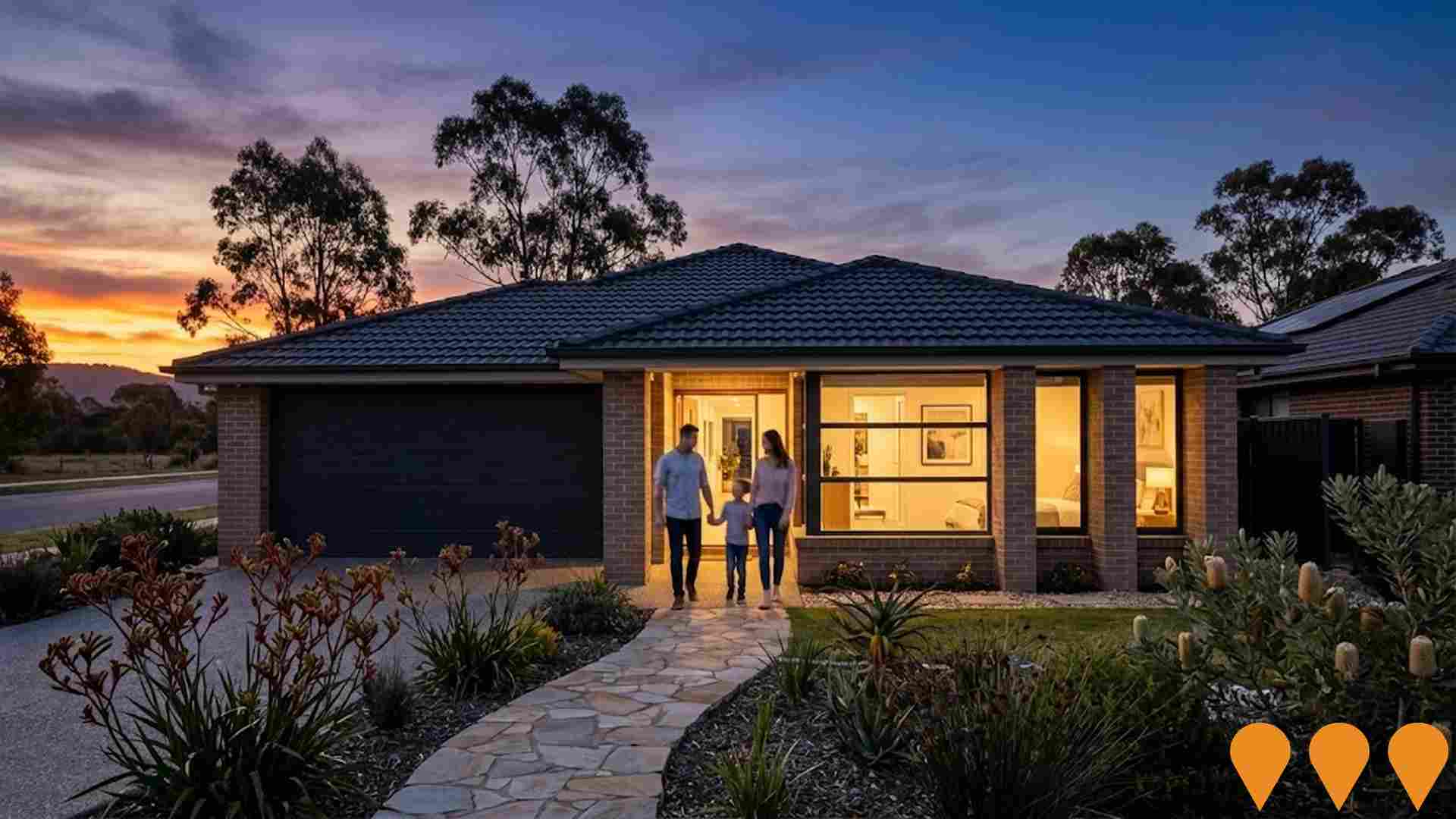Chart Color Schemes
est. as @ -- *
ABS ERP | -- people | --
2021 Census | -- people
Sales Activity
Curious about local property values? Filter the chart to assess the volume and appreciation (including resales) trends and regional comparisons, or scroll to the map below view this information at an individual property level.
Find a Recent Sale
Sales Detail
Population
Population growth drivers in Bacchus Marsh Surrounds are strong compared to national averages based on AreaSearch's ranking of recent, and medium to long-term trends
Based on AreaSearch's analysis, Bacchus Marsh Surrounds' population is around 6842 as of Aug 2025. This reflects an increase of 283 people (4.3%) since the 2021 Census, which reported a population of 6559 people. The change is inferred from the estimated resident population of 6725 from the ABS as of June 2024 and an additional 160 validated new addresses since the Census date. This level of population equates to a density ratio of 6.6 persons per square kilometer, providing ample space per person. Over the past decade, Bacchus Marsh Surrounds has demonstrated resilient growth patterns with a compound annual growth rate of 1.4%, outpacing the SA3 area. Population growth for the area was primarily driven by natural growth contributing approximately 53.8% of overall population gains during recent periods, although all drivers including overseas migration and interstate migration were positive factors.
AreaSearch is adopting ABS/Geoscience Australia projections for each SA2 area, as released in 2024 with 2022 as the base year. For any SA2 areas not covered by this data, AreaSearch is utilising the VIC State Government's Regional/LGA projections released in 2023 with adjustments made employing a method of weighted aggregation of population growth from LGA to SA2 levels. Growth rates by age group from these aggregations are also applied across all areas for years 2032 to 2041. Moving forward with demographic trends, projections indicate a decline in overall population, with the area's population expected to decline by 399 persons by 2041 according to this methodology. However, growth across specific age cohorts is anticipated, led by the 25 to 34 age group, which is projected to expand by 162 people.
Frequently Asked Questions - Population
Development
Recent residential development output has been above average within Bacchus Marsh Surrounds when compared nationally
Bacchus Marsh Surrounds has seen around 41 dwellings receive development approval annually. Over the past five financial years, from FY-21 to FY-25207 homes were approved, with a further 10 approved in FY-26. On average, 1.8 people moved to the area each year for every dwelling built over these five years.
This suggests a balanced supply and demand dynamic, contributing to stable market conditions. The average construction cost of new properties is $441,000. In the current financial year, there have been $4.3 million in commercial approvals, indicating the area's residential focus.
Compared to the rest of Victoria, Bacchus Marsh Surrounds has 11.0% lower construction activity per person but ranks at the 67th percentile nationally for areas assessed. New developments consist of 90.0% detached dwellings and 10.0% attached dwellings, maintaining the area's traditional low density character with a focus on family homes. With approximately 215 people per approval, Bacchus Marsh Surrounds reflects a low-density area. Population projections indicate stability or decline, which should reduce housing demand pressures, benefiting potential buyers.
Frequently Asked Questions - Development
Infrastructure
Bacchus Marsh Surrounds has emerging levels of nearby infrastructure activity, ranking in the 31stth percentile nationally
Changes to local infrastructure significantly influence an area's performance. AreaSearch has identified 21 projects likely impacting the region. Notable initiatives include Autumn Grove Estate, Ballan Library and Community Hub, Ballan Precinct 5 Residential Development, and Bacchus Marsh Grammar - Maddingley Campus Expansion. The following list details those most relevant.
Professional plan users can use the search below to filter and access additional projects.
INFRASTRUCTURE SEARCH
 Denotes AI-based impression for illustrative purposes only, not to be taken as definitive under any circumstances. Please follow links and conduct other investigations from the project's source for actual imagery. Developers and project owners wishing us to use original imagery please Contact Us and we will do so.
Denotes AI-based impression for illustrative purposes only, not to be taken as definitive under any circumstances. Please follow links and conduct other investigations from the project's source for actual imagery. Developers and project owners wishing us to use original imagery please Contact Us and we will do so.
Frequently Asked Questions - Infrastructure
Bacchus Marsh Central
A major mixed-use town centre redevelopment delivering a new Coles supermarket, fresh food precinct, medical centre, childcare, gym and over 150 apartments in the heart of Bacchus Marsh. The project forms part of the Bacchus Marsh Town Centre Structure Plan which was adopted by the Council in September 2024 and seeks to strengthen the town center's role as the primary civic, employment, and retail precinct in the Shire. Intersection upgrades are planned nearby, moving towards construction in 2026.
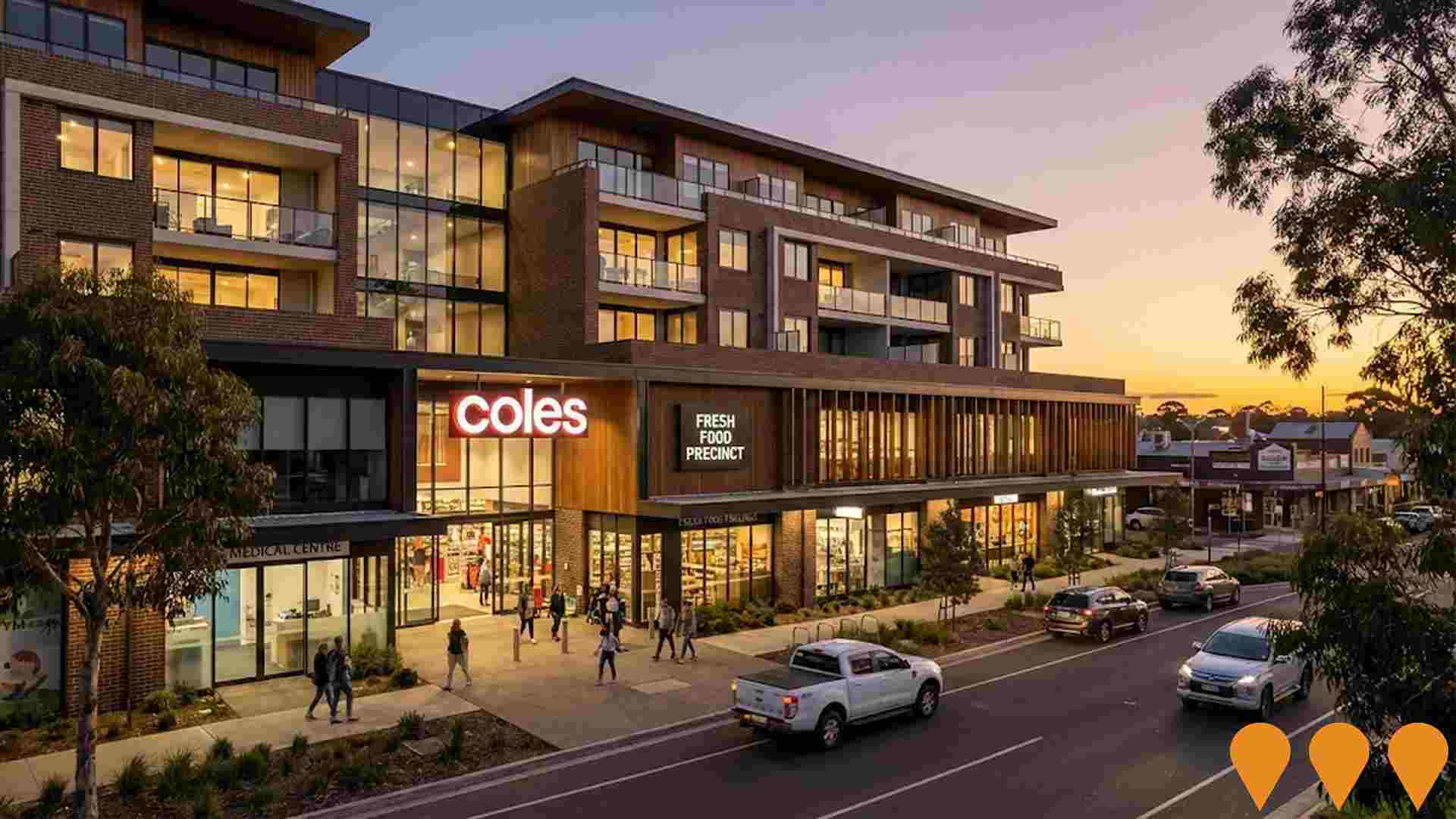
Rockbank Precinct Development
752-hectare greenfield precinct in Melbourne's west guided by the Rockbank Precinct Structure Plan. The PSP provides for more than 8,000 homes (circa 22,000 residents), a major town centre around Rockbank Station, schools, sports reserves and local infrastructure. Development is progressing across multiple private estates under the oversight of the Victorian Planning Authority and Melton City Council.
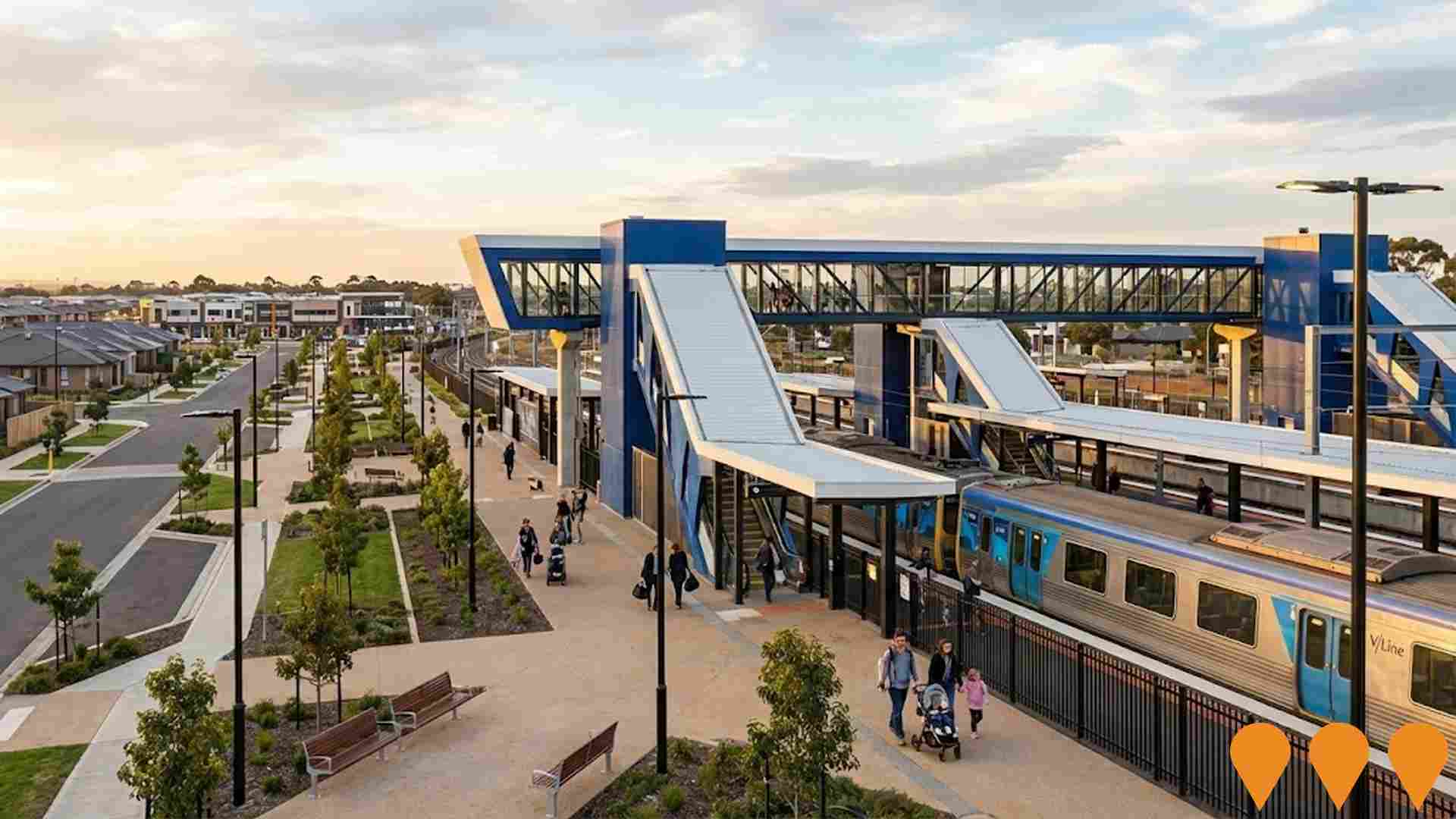
Ballan Library and Community Hub
A new, modern library and civic plaza officially opened in September 2025. The $7.25 million hub includes library services, youth and children areas, Maternal and Child Health services, an art exhibition space, a Visitor Information Centre, and community meeting rooms. The project was funded by the Victorian Government's Growing Suburbs Fund, the Living Libraries Infrastructure Program, Moorabool Shire Council, and the Ballan and District Community Hospital. The facility was designed by Croxon Ramsay Pty Ltd. and constructed by AW Nicholson. It officially opened to the public on September 6, 2025.
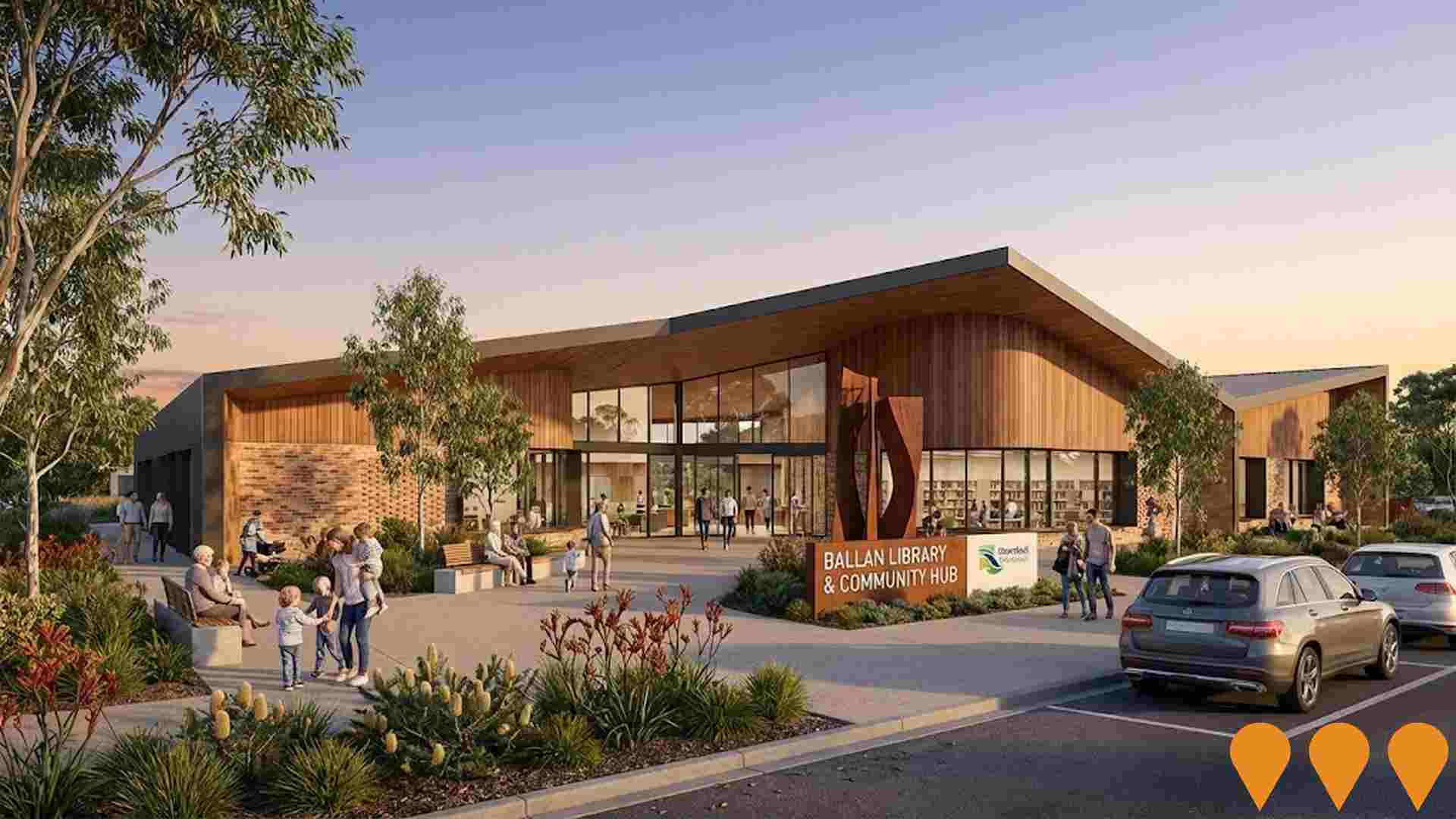
Ballan Precinct 5 Residential Development
Planning Scheme Amendment C108 proposes rezoning approximately 98.5 hectares of land (Precinct 5 in the Ballan Framework Plan) from Rural Living Zone to Neighbourhood Residential Zone Schedule 10 to facilitate a staged masterplanned residential community of approximately 930-937 dwellings. The precinct is bounded by the Western Freeway, Geelong-Ballan Road, Old Melbourne Road, and the Werribee River. The amendment was exhibited early 2025, received submissions, underwent a Planning Panel hearing in July 2025, and the Panel report was released in September 2025. Moorabool Shire Council is considering the Panel's recommendations for adoption as of late 2025.
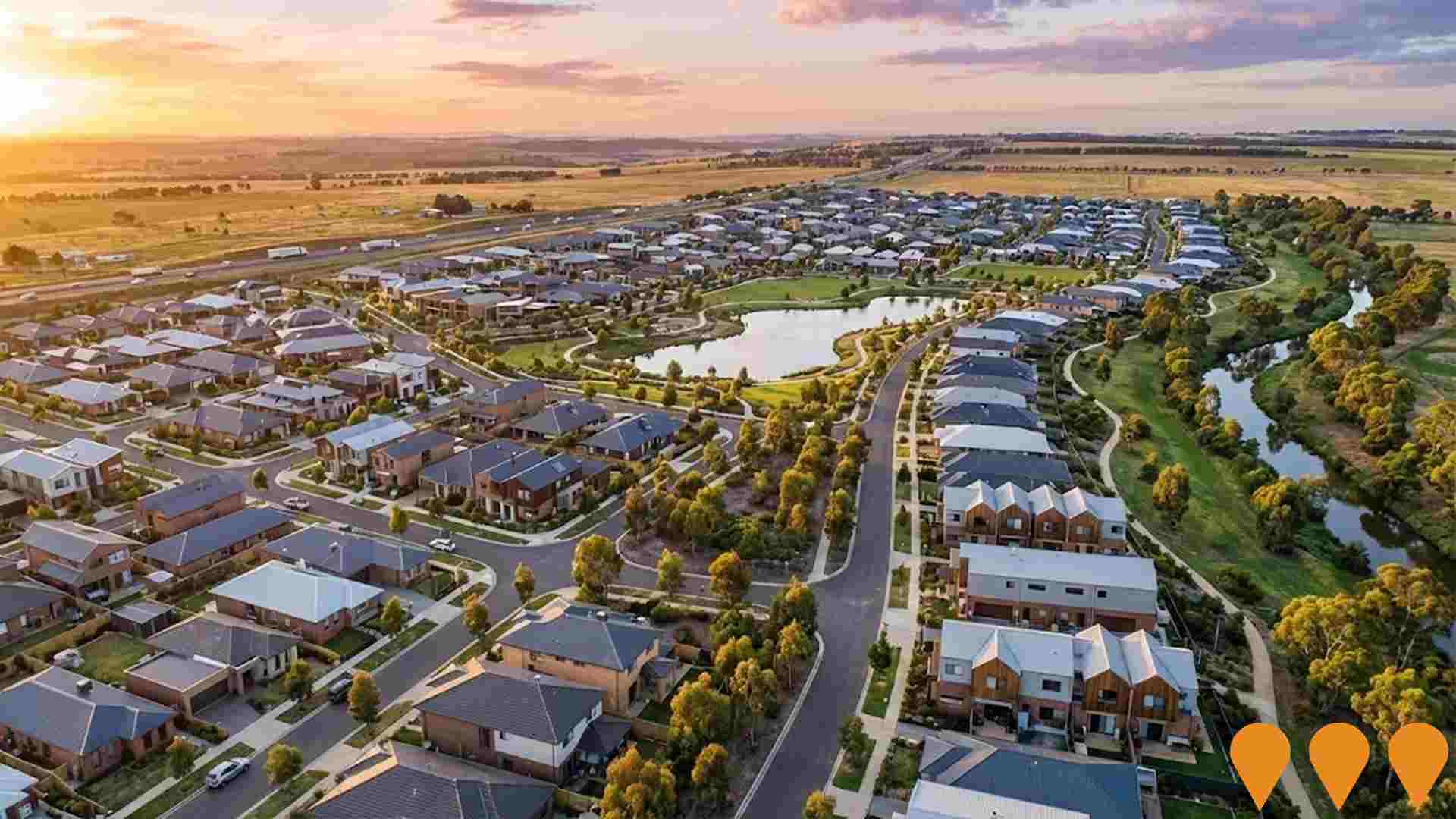
West Maddingley Early Years and Community Hub
An integrated community hub providing early years services, kindergarten places for 132 children, maternal and child health consulting rooms, multipurpose spaces, and support for families in a growing area. The project was jointly funded by Moorabool Shire Council and the Victorian State Government through the Growing Suburbs and Building Blocks funding streams. It was completed for the 2024 kindergarten year.
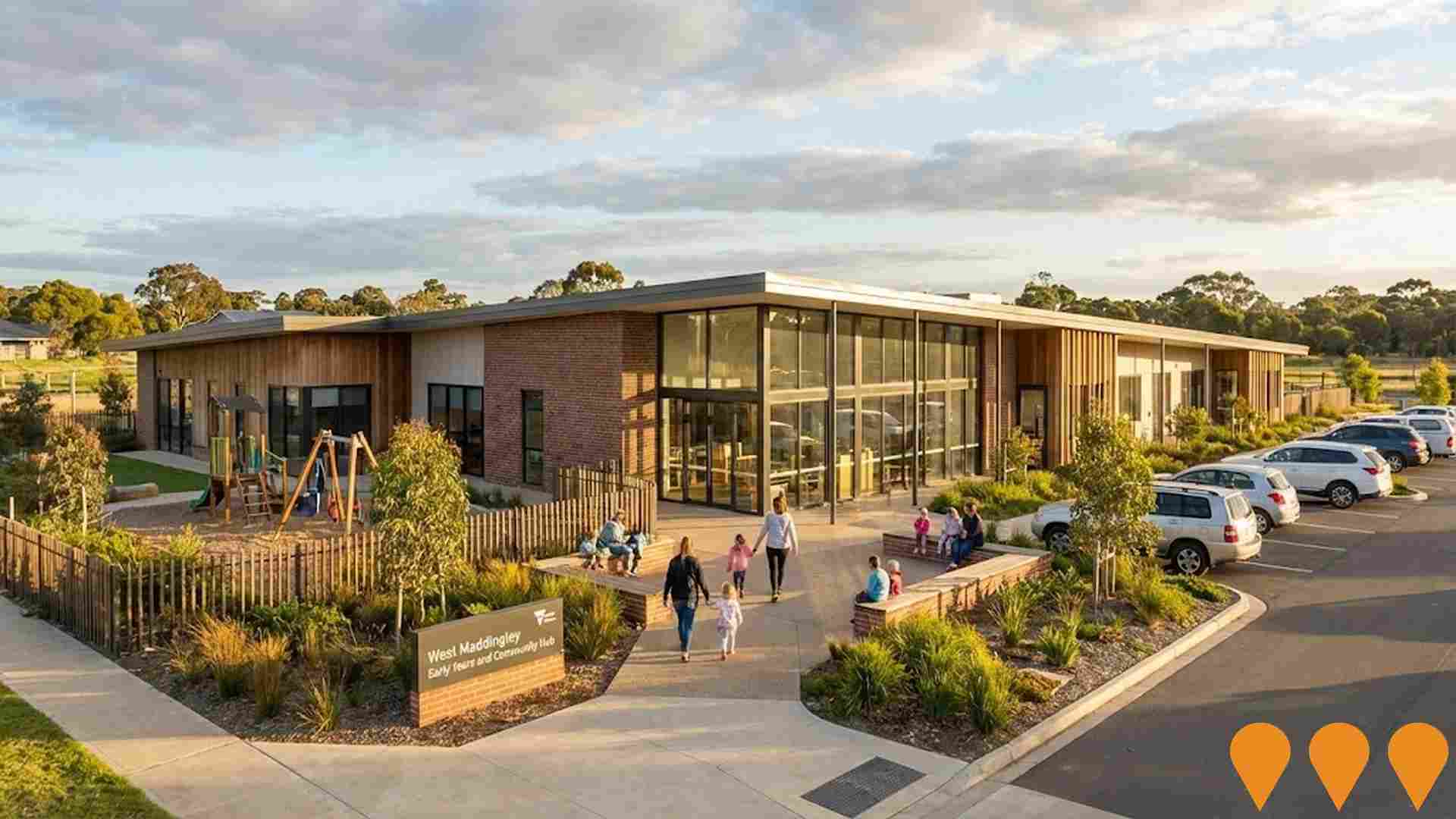
Bacchus Marsh Grammar - Maddingley Campus Expansion
Multi-stage expansion of Bacchus Marsh Grammar's Maddingley campus. Recent approvals include a new $14.5 million two-storey science faculty with laboratories, two amphitheatres, classrooms, offices, a rooftop garden, and associated external works. The expansion also recently included a new three-storey Library/Classroom facility (The Hive) and a Southern Sports Precinct with multi-use courts, as well as the acquisition of an additional 12 acres of land for playing fields and recreational space.
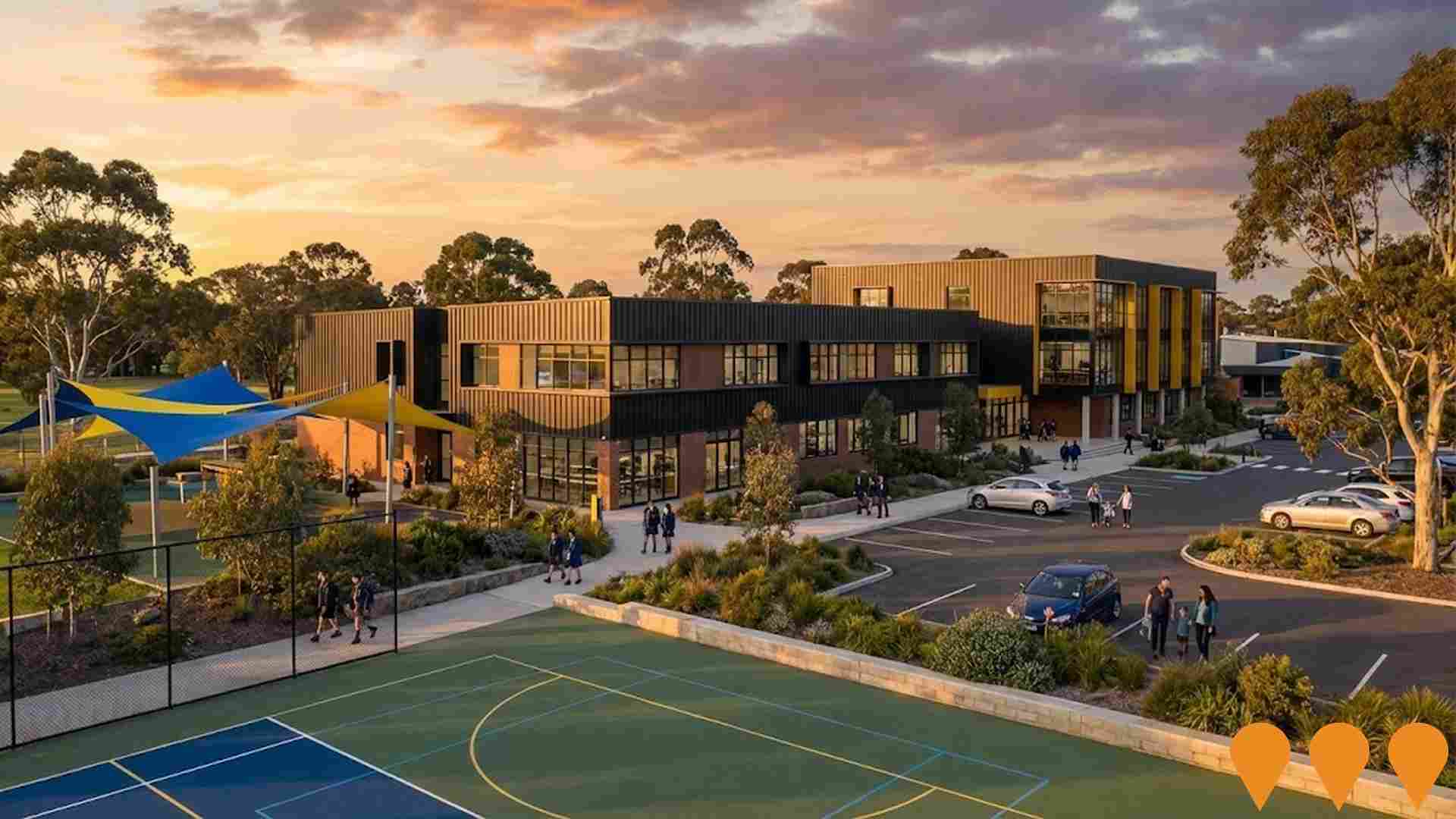
Darley Sports and Community Hub
The $5.2 million Darley Sports and Community Hub, officially opened in October 2023, provides a multi-purpose pavilion with three new community spaces, female-friendly player and umpire change rooms, an office, storage, a kitchen, and other amenities to support local sports (AFL, netball, cricket) and community activities.

Federation Park Upgrade
A major upgrade to Federation Park in Darley. The project includes replacement of the existing playground with new equipment, a new amenities block (including accessible and gender-neutral facilities), an upgraded and sealed car park, picnic facilities, seating, a drinking fountain, new pathways, and landscaping. The project aims to enhance community recreation and accessibility while celebrating the park's historical significance, with an artistic impression on the amenities block referencing the Darley Training Camp recruits.

Employment
The labour market strength in Bacchus Marsh Surrounds positions it well ahead of most Australian regions
Bacchus Marsh Surrounds has a skilled workforce with essential services sectors well represented. The unemployment rate is 2.1%.
Over the past year, there was an estimated employment growth of 7.2%. As of June 2025, 3,597 residents are employed while the unemployment rate is 1.7% lower than Rest of Vic.'s rate of 3.8%. Workforce participation is at 62.1%, compared to Rest of Vic.'s 57.4%. The dominant employment sectors among residents include construction, health care & social assistance, and public administration & safety.
Construction employs a particularly high share of local workers, at 1.5 times the regional level. However, health care & social assistance employs only 11.9% of local workers, below Rest of Vic.'s 16.8%. The area may offer limited employment opportunities locally, as indicated by the count of Census working population versus resident population. Between June 2024 and June 2025, employment levels increased by 7.2%, labour force increased by 6.9%, resulting in a fall in unemployment by 0.3 percentage points. In contrast, Rest of Vic. saw employment fall by 0.9%, labour force contract by 0.4%, and unemployment rise by 0.4 percentage points. Jobs and Skills Australia's national employment forecasts from May 2025 project national employment growth of 6.6% over five years and 13.7% over ten years. Applying these projections to Bacchus Marsh Surrounds' employment mix suggests local growth of approximately 6.1% over five years and 12.7% over ten years, though this is a simple weighting extrapolation for illustrative purposes only.
Frequently Asked Questions - Employment
Income
The economic profile demonstrates above-average performance, with income metrics exceeding national benchmarks based on AreaSearch comparative assessment
AreaSearch released postcode level ATO data for financial year 2022 on Bacchus Marsh Surrounds. The median income among taxpayers was $54,237 with an average of $67,233. Nationally, the median income was lower at $48,741 and the average was $60,693. By September 2025, estimates based on a 12.16% Wage Price Index growth would be approximately $60,832 (median) and $75,409 (average). Census 2021 income data shows Bacchus Marsh Surrounds ranks modestly for household, family and personal incomes, between the 43rd and 49th percentiles. The largest income segment comprises 34.7% earning $1,500 - 2,999 weekly, with 2,374 residents in this cohort. After housing costs, 86.4% of income remains for other expenses. The area's SEIFA income ranking places it in the 5th decile.
Frequently Asked Questions - Income
Housing
Bacchus Marsh Surrounds is characterized by a predominantly suburban housing profile, with ownership patterns similar to the broader region
The dwelling structure in Bacchus Marsh Surrounds, as per the latest Census, consisted of 96.0% houses and 4.1% other dwellings (semi-detached, apartments, 'other' dwellings). This is comparable to Non-Metro Vic.'s 96.1% houses and 3.9% other dwellings. Home ownership in Bacchus Marsh Surrounds was at 37.8%, with the remaining dwellings either mortgaged (49.0%) or rented (13.2%). The median monthly mortgage repayment in the area was $1,700, higher than Non-Metro Vic.'s average of $1,538. The median weekly rent figure was recorded at $330, compared to Non-Metro Vic.'s $300. Nationally, Bacchus Marsh Surrounds's mortgage repayments were lower than the Australian average of $1,863, while rents were substantially below the national figure of $375.
Frequently Asked Questions - Housing
Household Composition
Bacchus Marsh Surrounds has a typical household mix, with a higher-than-average median household size
Family households constitute 73.8% of all households, including 32.5% couples with children, 30.0% couples without children, and 10.6% single parent families. Non-family households account for the remaining 26.2%, with lone person households at 24.2% and group households comprising 2.0%. The median household size is 2.5 people, which is larger than the Rest of Vic. average of 2.4.
Frequently Asked Questions - Households
Local Schools & Education
Educational attainment in Bacchus Marsh Surrounds aligns closely with national averages, showing typical qualification patterns and performance metrics
The area's university qualification rate is 21.4%, significantly lower than Victoria's average of 33.4%. Bachelor degrees are the most common at 14.0%, followed by postgraduate qualifications (3.9%) and graduate diplomas (3.5%). Vocational credentials are prevalent, with 41.3% of residents aged 15+ holding them, including advanced diplomas (11.4%) and certificates (29.9%). Educational participation is high at 28.5%, comprising 11.0% in primary education, 8.0% in secondary education, and 3.4% in tertiary education.
The five schools in the area have a combined enrolment of 583 students and offer balanced educational opportunities, with an ICSEA score of 997. There are four primary schools and one secondary school serving distinct age groups.
Frequently Asked Questions - Education
Schools Detail
Nearby Services & Amenities
Transport
Transport servicing is moderate compared to other areas nationally based on assessment of service frequency, route connectivity and accessibility
Bacchus Marsh Surrounds has five active public transport stops operating, offering a mix of train and bus services. These stops are served by 13 individual routes, collectively facilitating 625 weekly passenger trips. Transport accessibility is rated as limited, with residents generally located 4367 meters from the nearest stop.
Services run an average of 89 trips per day across all routes, translating to approximately 125 weekly trips per individual stop.
Frequently Asked Questions - Transport
Transport Stops Detail
Health
Health performance in Bacchus Marsh Surrounds is lower than average with common health conditions somewhat prevalent across both younger and older age cohorts
Bacchus Marsh Surrounds faces significant health challenges with common health conditions prevalent across both younger and older age cohorts.
Approximately 53% (3,653 people) have private health cover. The most common medical conditions are arthritis (9.9%) and mental health issues (8.6%). About 65.0% of residents report no medical ailments compared to 63.5% in Rest of Vic.. The area has 19.5% (1,332 people) aged 65 and over, lower than the 24.2% in Rest of Vic.. Health outcomes among seniors present challenges broadly in line with the general population's health profile.
Frequently Asked Questions - Health
Cultural Diversity
Bacchus Marsh Surrounds is considerably less culturally diverse than average when assessed alongside AreaSearch's national rankings for language and cultural background related metrics
Bacchus Marsh Surrounds, as per the data, had a lower than average cultural diversity with 89.4% of its population being citizens and 86.4% born in Australia. English was spoken exclusively at home by 95.7% of the population. Christianity was the predominant religion, accounting for 46.6%.
Judaism, however, was slightly overrepresented at 0.1%, compared to the regional average of 0.1%. The top three ancestry groups were Australian at 30.1%, English at 29.4%, and Irish at 10.2%. Notably, Maltese (2.7% vs 1.3%), Macedonian (0.3% vs 0.2%), and Scottish (8.5% vs 9.9%) were overrepresented in Bacchus Marsh Surrounds compared to the regional averages.
Frequently Asked Questions - Diversity
Age
Bacchus Marsh Surrounds hosts an older demographic, ranking in the top quartile nationwide
The median age in Bacchus Marsh Surrounds is 43 years, matching the Rest of Vic figure and exceeding the national average of 38 years. The age profile indicates that those aged 35-44 are notably prominent at 14.8%, while the 65-74 group is relatively smaller at 10.7% compared to Rest of Vic. Between the 2021 Census and now, the 75 to 84 age group has grown from 5.6% to 7.0% of the population, and the 15 to 24 cohort has increased from 9.5% to 10.7%. Conversely, the 5 to 14 age group has decreased from 13.1% to 11.9%. Looking forward to 2041, demographic projections show significant shifts in Bacchus Marsh Surrounds' age structure. Notably, the 25 to 34 group is expected to grow by 19 people (to 806 from 678), while population declines are projected for the 45 to 54 and 75 to 84 cohorts.
